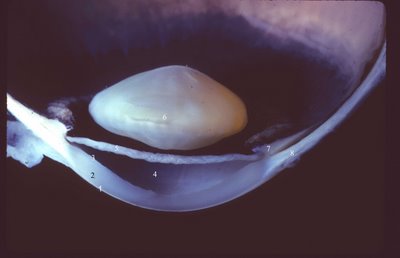
Photograph of a human eye that has been bisected in the coronal plane to show the view of the anterior segment from a posterior perspective (as though you are looking from the retina). The crystalline lens is suspended by delicate fibers called the zonule. The ciliary body (CB) is composed of about 72 processes that make up the pars plicata and a flat area called the pars plana. The ora serrata (ora) is the place where the retina joins the ciliary body.
Below is a cross section of an eye with the various structures numbered.

Click on the photograph to get higher magnification and then after you have identified the structure, verify by checking the key below.
1. Epithelium (cornea) 2. Stroma (cornea)
3. Descemet's membrane and endothelium (cornea)
4. Anterior chamber
5. Iris
6. Lens
7. ciliary body
8. sclera
The photo below is convenient to study the flow of aqueous from the ciliary epithelium of the ciliary body through the posterior chamber and the narrow space between the iris and lens into the anterior chamber and then in the anterior chamber angle and trabecular meshwork, Schlemm's canal and the collector vessels. Anatomic pertubations that may obstruct this flow include apposition of peripheral iris against the cornea (known as angle closure glaucoma), apposition of the iris against the lens because of rotation of the ciliary body leading to (malignant glaucoma), obstruction of the trabecular meshwork (such as in hemorrhage known as ghost cell glaucoma), adherence of the pupillary margin of the iris to the lens as after severe inflammation), and back pressure on the system such as a tumor that obstructs aqueous veins or a carotid cavernous sinus fistula that produces elevation of venous pressure and blood can sometimes be seen in aqueous veins.
CLICK ON THE PHOTO TO ENLARGE AND IDENTIFY THE NUMBERED STRUCTURES
.
TO SEE THE ANSWERS Click here
After you have learned these structures click on <
Next>
